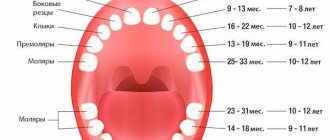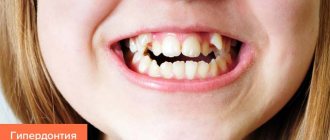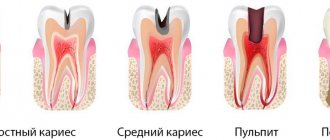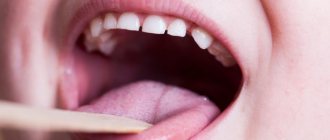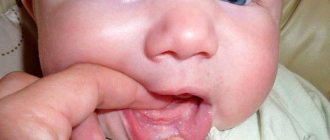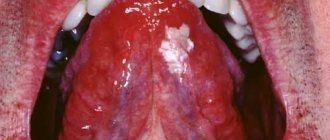Polyodontia is an abnormal number of teeth.
In medicine, this disease is often called hyperdontia, and “extra” dental elements are called supernumerary teeth. Research is still being conducted into why this pathology occurs. Most scientists associate it with disturbances in the formation of tooth germs.
Nature provides that a person grows no more than 20 milk teeth and 32 permanent teeth in a lifetime, but exceptions occur, and in our time quite often. According to statistics, on average, dental anomalies occur in 2% of the world's population, most often in men.
In 2014 alone, two operations were performed, in one of which 80 teeth were removed, and in the other, a record 232 teeth. Until this time, the maximum figure was 37 teeth.
The most common hyperdontia (anomaly in the number of teeth) is an anomaly of the upper incisors. Supernumerary teeth are less common among the lower incisors and in other parts of the jaw. They can come in a wide variety of shapes and sizes. These are usually small, cone-shaped teeth.
Extra teeth lead to deformation of the dentition, so it is recommended to remove supernumerary elements. Another reason for removal is that most patients with this pathology have a lisp.
The formation of extra teeth is quite common today. According to statistics, 70% of patients have only one extra incisor, in 25% of cases – 2 supernumerary elements, and only 5% of all patients have 3 or more teeth during examination.
Which animal has 28 teeth? Why do some people only have 28 teeth?
Any medical reference book contains information about a person having 32 teeth.
Of these, eight are incisors, four canines and 20 large and small molars. This is considered normal for an adult aged 25 years and older. Dental consultant Nadezhda Alekseeva explains that a person’s adult row of permanent teeth is formed by the age of sixteen. But at this time there are only 28 of them. Four molars, the so-called wisdom teeth, grow only by the age of twenty-five. However, not all. According to statistics, 25 percent of the world's population has no wisdom teeth at all. This is how they live with 28 teeth.
Logically, those with an incomplete set of teeth should feel uncomfortable. But this doesn't happen. There are no inconveniences. Sixteen molars instead of twenty do an excellent job of chewing food. Nadezhda Alekseeva explains that such a number of teeth may be due to genetic predisposition, dietary habits, or be an evolutionary development. The first reason is more or less clear. But the second and third are closely related.
Anthropologists have found that our distant ancestors had 44 teeth. This was necessary, since a person ate raw food, as a result of eating it, he often had to tear it with his teeth, especially if it was meat. But as a result of evolution, when meat and other products began to be subjected to heat treatment and food became much softer, the number of teeth in humans began to decrease, reaching 32. And now the number 28 no longer bothers anyone. Dentist, surgeon, orthopedist Sultan Gadzhiev explains that in 80 percent of cases, wisdom teeth are sure to appear in people who eat a lot of raw vegetables and fruits. Also, according to the doctor, all four third molars (the medical name for this type of molar) usually erupt in residents of the southern regions. This is facilitated by the high content of vitamin D in the body, which the sun generously supplies it with.
Scientists say: due to the fact that people's food is becoming more and more soft, a person's jaw row will continue to thin out. Nature cannot tolerate useless elements and gets rid of them in the process of evolution.
In the USA they approach this issue differently. American dentist Jerome Lawrence explains: just some two hundred years ago, the average human life expectancy did not exceed 45-50 years. By this time, even if people’s teeth were falling out, not all of them were falling out. Now a person lives almost twice as long. And by the age of 70, he loses most of his teeth. Implants do not take root in everyone, but if they take root, a person is not always able to use them freely. And the wisdom teeth, which appear last, become the anchors on which the foundations of the artificial jaw are then attached.
For Russia, this is all the more important since not every pensioner can afford even one implant, let alone a larger number.
Nadezhda Alekseeva talks about a new trend when, at the slightest inconvenience that the appearance of wisdom teeth brings, people try to get rid of them. If the tooth grows normally, you just need to wait out the unpleasant sensations and under no circumstances remove it. In old age, these teeth can be very helpful, the dentist is sure.
However, if the wisdom tooth grows incorrectly, is initially curved, and its appearance puts pressure on the jaw, as a result of which it begins to undergo deformation, it must be urgently removed. The same should be done with a crooked wisdom tooth, even if it does not cause any inconvenience. It is very difficult to clean, and no matter how hard you try, it is almost impossible to completely get rid of plaque and germs. This means that this tooth will become a source of spread of putrefactive bacteria and caries.
Causes of polyodontia
Medicine has not yet found an exact answer to the question of what are the causes of supernumerary teeth. Scientists put forward several hypotheses:
- Atavism. Supernumerary teeth are explained by the fact that the dental system strives to return to the original number of elements laid down by nature. There is evidence that our ancestors had 6 incisors on both the lower and upper jaws. As a result, many doctors consider atavism to be the cause of the development of polyodontia in humans.
- Splitting of the tooth germ. Even in the embryonic period, the activity of the dental plate is disrupted in the child, as a result of which hyperdontia is formed. Violations can be caused by viruses, poor ecology, drugs, medications prohibited during pregnancy, alcohol and other factors. This hypothesis is increasingly supported today, because recently the disease has been rapidly progressing due to bad habits and poor ecology.
The causes of hyperdontia continue to be researched. Scientists cannot give an exact explanation for this anomaly, but most of them are inclined to the second hypothesis - the splitting of the tooth germ at the embryonic stage.
Complications caused by polyodontia
Supernumerary teeth appear more often on the upper jaw in the permanent dentition, and are less common on the lower jaw and in the primary dentition. Their appearance threatens with the following complications:
- Development of anomalies of the dental system: change in the position of complete teeth: their displacement to the sides, forward or backward, rotation around an axis;
- bite deformation, as a result – disruption of chewing and speech functions;
- disruption of the eruption of permanent teeth, up to the loss of their ability to erupt;
- the appearance of a diastema - a pathological distance between the central incisors;
- the formation of three spaces between the remaining teeth.
- chronic gingivitis;
The eruption of supernumerary teeth is often accompanied by the following symptoms:
- increased body temperature;
- pain and swelling in the eruption area;
- increased salivation;
- swelling of the nasal mucosa.
Supernumerary teeth affect not only the visual component of the smile, but also cause systemic disorders that lead to deterioration in chewing food and disruption of the stability of the main teeth. All this also affects a person’s psychological comfort: he becomes withdrawn, does not smile, so as not to demonstrate smile defects.
What does polyodontia look like?
Quite often, extra teeth are almost indistinguishable from normal ones. It is not uncommon for them to grow in the form of a drop or a thorn. These dental elements can appear either individually or fused with permanent ones. They can form tooth-like formations and entire arrays of teeth.
Also in medical practice, there are cases where polyodontia was hidden and was detected only by radiography. There are many different cases of abnormal development of the number of teeth, and if you notice symptoms, you should definitely contact the dentist.
Types of polyodontia disease
Polyodontia in the oral cavity manifests itself in different ways. By studying the statistics, signs and symptoms of the disease, dentists were able to classify the types of this anomaly.
Depending on the origin, the disease is divided into two types:
- False polyodontia. Provides for a baby tooth that does not fall out, regardless of the person’s age. At the same time, it fulfills its functions, does not create discomfort to the bite, and is firmly fixed in the patient’s jaw. In addition, teeth fused together and other anomalies are classified as a false type of disease.
- True polyodontia. It can be caused by genetic predisposition, as well as terogenic factors. At the same time, extra molars begin to form in the human jaw.
How many teeth should a person have?
In fact, 32 is the maximum number of teeth that a person can grow, excluding some diseases when there may be more teeth. However, in life this is not always the case. The process of replacing baby teeth with molars is completed at approximately the age of 14, and there are 28 of them in total. They are divided into the following groups:
- Incisors. They have a sharp, chisel-shaped shape and are located in the front of the jaw (four upper and four lower). Their main function is to bite food.
- Fangs. They have a pointed shape and are designed to grab and tear food.
- Small indigenous. They have two sharp bumps on the chewing surface and are designed for grinding food.
- Molars. They have several tubercles on the upper surface and are designed for grinding food.
In total, their number can range from 28 to 32. What are these 4 lost teeth? They are called molars or, as they are called in medical terminology, third molars. Not everyone grows them and not always in the amount of 4 pieces.
As for the placement of extra teeth, dentists distinguish the following types of disease:
- Typical hyperdontia. Applies to those patients in whom extra teeth appear only in the dentition and do not extend beyond it. Many scientists are confident that this is simply heredity, because our ancestors had a more developed dental system than modern people.
- Atypical hyperdontia. It occurs much less frequently and is characterized by the appearance of teeth outside the dentition.
In case of anomalies with baby teeth, the latter pose almost no threat. On the contrary, such a tooth can last a lifetime. But the permanent molars, over which the supernumeraries grow, should be removed, if only because it is not aesthetically pleasing.
Often, the patient grows extra fangs or incisors, or even several front teeth at once. In addition to a ruined smile, the disease can cause serious complications if the necessary measures are not taken in time.
Symptoms of the disease in children
The first supernumerary teeth in children appear before birth or in the first six months of life. The main inconvenience they cause is difficulty in feeding.
Polyodontia of primary teeth in older children occurs with symptoms similar to the eruption of regular teeth. In this case it is observed:
- temperature increase;
- swelling of the gums in the place where the tooth should erupt;
- pain;
- excessive salivation;
- swelling of the nasal mucosa;
- loose stool.
Symptoms are especially severe when extra teeth appear in the upper palate.
If hyperdontia makes itself felt in a two-year-old child, this can interfere with the formation of normal speech. In turn, due to injury to the tongue and mucous membranes, some kind of inflammation constantly appears in the oral cavity.
When supernumerary teeth appear in very noticeable places in school-age children, ridicule towards the patient may occur, which is fraught with the development of psychological problems and complexes in the future.
Polyodontia (supernumerary teeth) - symptoms and treatment
For a successful prognosis in treatment, high-quality and timely diagnosis of patients is very important. The dentist-therapist must know the basic clinical manifestations and principles of diagnosing hyperdentia. This is especially important in the work of a pediatric specialist during periods of medical examination and planned sanitation of the oral cavity in children. This makes it possible to identify the presence of this anomaly at an early age and carry out appropriate treatment in the early stages.
Most often, “extra” teeth are located in the anterior part of the upper jaw. The question of the exact location of supernumerary teeth is very important, since the surgical stage of treatment depends on this. The more accurately the position of various anatomical formations is determined, the less surgical trauma (damage to the growth zones of complete teeth, the formation of large defects in the bone of the alveolar process) will result from the surgical stage of treatment. The volume and time of the procedure will be reduced, which is very important when it comes to treating children. The position of the causative tooth can be determined using instrumental examination methods:
- CT scan;
- orthopantomography;
- intraoral radiography;
- visiography;
- Magnetic resonance imaging.
Computed tomography allows you to obtain a cross-sectional, layer-by-layer image of any area of the human body, including the skull. Dental (dental) X-ray computed tomography allows you to make 4 types of images in different planes in one and a half minutes. The radiation dose with this examination method is less than other types of CT. The procedure is easily tolerated by patients and does not require special training, which is convenient when working with children. In addition, it is as informative as possible for the doctor.
Orthopantomography is a method of x-ray examination in which you can obtain an image of all the patient’s teeth, upper and lower jaws, adjacent tissues and areas of the facial skeleton. Conducted for children from 3-4 years old. This is a quick, simple, highly effective method that helps identify oral diseases in the early stages. It has virtually no clinical contraindications and is actively used by dentists.
Intraoral radiography is the simplest, most common diagnostic method in therapeutic dentistry. The picture shows from one to 3-4 teeth and adjacent formations. For the pathology under consideration, the method is not informative enough, but can be used if the above types of diagnostics are unavailable.
Visiography is a system for obtaining X-ray images without the use of film. In this type of research, instead of film, a special sensor is used, from which the image is transferred to a computer, after which it is processed and then saved. Advantages of this technique:
- The radiation exposure to the patient is tens of times lower compared to the most advanced film X-ray, which is extremely important for both the patient and the radiologist.
- Scalability and the possibility of mathematical image processing (measuring the size, density of objects, etc.).
- It is possible to store the received information and create your own database for each patient.
- There is the possibility of instant transfer of diagnostic data directly from the treatment room to the computer monitor of the attending doctor, wherever he is. This is very convenient if you need to consult doctors from different clinics or from different cities.
But, as with intraoral radiography, the image produces a low-informative planar image of the area under study, limited to 1-4 teeth.
Magnetic resonance imaging is a radiation diagnostic method that can be used to obtain an image of the layers of the human body in any plane. The method is simple and does not have any harmful effects on the body of the subject. A contraindication for MRI is the presence of metal foreign bodies (dentures, braces, surgical pins, etc.) in the patient’s body.
Sometimes, to determine the level of location of problem teeth, Yu.I.’s technique Zhigurta (1994). It consists of studying an orthopantomogram of the jaws and marking on it the four levels of occurrence of unerupted incisors and canines. However, this method is imperfect and does not allow an accurate assessment of where the supernumerary tooth is located. It is more advisable to use modern diagnostic methods described above.
To more accurately determine the relationship of the additional tooth with the roots and rudiments of the complete teeth, contact intraoral radiographs are taken in the preoperative period and 1, 3, 6 and 12 months after the operation. They are used to determine the degree of change in the position of the impacted tooth, the condition of the root of the complete tooth and the morphological structure of the bone of the alveolar process in the studied area [1][7][8].
Symptoms of hyperdontia in adults
Polyodontia affects permanent teeth more often than baby teeth. An adult usually develops dystopic and impacted supernumerary teeth.
Dystopic teeth are those that appear outside the dental arch. Most often they erupt on the lingual surface of the gums and in the palate. With this form of the disease, the patient typically:
- poor pronunciation of sounds;
- noticeable malocclusion;
- change in the usual arrangement of teeth: curvature of the angle at which they grow, as well as their rotation
- around its axis;
- frequent injury to the oral mucosa and, as a result, its inflammation;
- disruption of chewing processes, resulting in digestive problems.
Among other things, dystopic teeth often cause psychological problems. Due to a non-aesthetic, and sometimes completely unattractive smile, the patient becomes withdrawn and uncommunicative. Psychological problems, in turn, cause chronic diseases of the endocrine, digestive and nervous systems.
Impacted supernumerary teeth are teeth that do not erupt, but continue to remain in the bone tissue of the human jaw. Often they hardly make themselves felt until complications begin. Dentists diagnose this anomaly during a routine examination of the patient.
This abnormality in the number of teeth is accompanied by the following symptoms:
- normal teeth begin to loosen (the condition is considered pathological);
- the bone begins to protrude (if the impacted tooth is too close to the edge of the jaw);
- Aching pains appear periodically.
One of the most difficult situations is when extra teeth grow in place of impacted third molars. Wisdom teeth cannot grow and begin to negatively affect the roots of other teeth, which in turn can lead to serious complications.
What should a parent be wary of in this case?
The strange shape of the erupted tooth, as well as its position in the dentition.
In adults, as a rule, there are no symptoms. Supernumerary teeth simply erupt and create discomfort, injuring the mucous membrane and making the bite incorrect, or they remain in the bone tissue without showing themselves.
In some cases, if there are impacted extra teeth, an adult may have:
- loosening of permanent units,
- periodic discomfort at the location of the extra tooth,
- bone deformation if the tooth is located at the edge of the jaw.
Consequences of polyodontia disease
Polyodontia in humans can often be the cause of retention. This is a phenomenon in which normal teeth are unable to erupt due to the interference of supernumerary teeth. The former may remain in the jaw or take an abnormal position.
In addition, even if the complete incisor grows before the supernumerary one, the latter will be able to displace it. This will lead to the person being unable to chew food normally. And if several extra incisors grow at once, they can cause the loss of permanent teeth.
Diagnostics
Examining supernumerary teeth during an x-ray is not as easy as it seems. They can be superimposed along the contour onto the permanent ones and remain invisible. In such cases, patients are recommended to undergo a computed tomography scan, which shows a more accurate picture of the disease.
If the extra dental elements have already erupted, the dentist can easily detect them. In practice, the patients themselves find the erupted supernumerary teeth and already at the initial appointment with the dentist they complain about the pathology.
When should supernumerary teeth be removed?
Reasons for removal may vary: from aesthetics to obvious damage to the health of the main dentition. Therefore, it makes sense to remove excess teeth if:
- There is a risk of losing a permanent healthy tooth.
- Retention of normal dental units is possible.
- Supernumerary teeth are carious or affected by other pathologies.
- Polyodontia distorts the normal dentition and spoils the smile with its unaesthetic shape and location in the mouth.
- Due to the growth of abnormal teeth, bite and diction are impaired, and the mucous membrane is injured.
- Threat of resorption of permanent row roots.
- The germ of an extra tooth produced a cystic formation.
When supernumerary teeth are “not conspicuous”, do not cause discomfort, and do not harm the normal dentition, then, in principle, they can be left alone. But still, in order to finally make a decision, careful studies using X-rays and computed tomography are needed, as well as consultation with an experienced specialist, so as not to miss any hidden problems from this dental pathology.
Symptom relief
Most often, in adults, extra teeth erupt without any symptoms, but for children this can become a problem that needs to be addressed.
Supernumerary teeth erupt with the same symptoms as regular teeth, so the treatment for them is the same.
- To lower the temperature, it is recommended to give your baby Paracetamol or Ibuprofen. If the child is very small, these drugs can be used in the form of suspensions or rectal suppositories. In addition to lowering the temperature, these medications do an excellent job of treating pain and inflammation.
- To relieve gum pain, local anesthetics are used - ointments and gels (for example, Kalgel, Dentinox, Solokoseryl). These remedies cope well with painful sensations and slightly relieve inflammation.
- Adults and children over 2 years of age can be treated with folk remedies: propolis, honey, decoctions of calendula, chamomile and lemon balm. Some decoctions help reduce pain and relieve inflammation. Traditional methods of treatment should be used only after consultation with your doctor.
- If primary supernumerary teeth have partially erupted, stimulation of eruption is prescribed. For this purpose, vibration and electrical stimulation, as well as special massage, are used.
Normal deletion
If the dentist decides that in a particular case, polyodontia can only be treated by removing an extra tooth, the patient should count on the following procedures:
- First of all, the patient should be sent for radiography. This is necessary in order to determine the size and number of roots, as well as the ratio of supernumerary and normal teeth.
- After collecting research, the doctor gives the patient anesthesia and removes excess teeth.
- In some cases, soft tissue sutures may be necessary after surgery.
Removal of impacted teeth
In order for the operation to be successful and polyodontia to be cured without any complications, the doctor must fully examine the patient and plan his further actions.
- To begin with, X-rays and/or computed tomography are performed to determine the exact topography of the anomaly.
- Removal is performed under local anesthesia, but there are cases when general anesthesia can be used on the patient.
- First, the mucous membrane is peeled off, then the bone tissue is opened and the root and crown parts of the tooth are removed.
- If necessary, bone defects are covered with osteoplastic material, and the mucous membrane is sutured.
After tooth extraction, the patient continues treatment at home: takes antibiotics (if prescribed by the attending physician), rinses the oral cavity with antiseptic solutions.
Until the wound heals after surgery, it is not recommended to eat too hot, hard or spicy food. You should also brush your teeth carefully, especially on the operated side.
Treatment
Relief of teething symptoms
Teething may be accompanied by the usual symptoms for this process: pain, itching, swelling of soft tissues, and sometimes fever; Children are especially sensitive to the teething process. To relieve symptoms use:
- Nonsteroidal anti-inflammatory drugs: paracetamol, ibuprofen. They are taken orally to reduce fever and reduce inflammation.
- Products for topical use: gels Dentol, Dentinox-N, Kamistad. The products are applied to the teething area and have analgesic and anti-inflammatory effects.
- From the age of three, rinsing with propolis tincture is allowed: 15 ml of tincture is diluted in 100 ml of warm boiled water, rinse the mouth up to five times a day.
- It is advisable to consult a doctor.
Tooth extraction
As a rule, the treatment of polyodontia consists of the removal of supernumerary teeth, which is carried out under local or general anesthesia. Extraction of an erupted, evenly positioned supernumerary tooth is usually not difficult; removal of impacted teeth is difficult. In this case, the surgeon makes an incision in the soft tissue to access the tooth, then saws it out of the bone tissue, completely removing it. After this, biomaterial is placed into the hole to restore bone tissue, and the wound is sutured.
Removal of a supernumerary tooth can be complicated by the proximity of its roots to the roots of permanent teeth, the large depth of the tooth and the irregular shape of the tooth being removed. Data from studies conducted using computed tomography provide great assistance in choosing a removal technique and making a treatment prognosis.
To avoid serious disorders of the dental system, it is advisable to visit an orthodontist. And children are recommended to have a consultation for prevention from the age of 3.
Sometimes, in order to prevent injury to the tooth germs of adjacent teeth, it is necessary to delay the removal of supernumerary teeth until they have fully or partially erupted. A delay is indicated if the extra teeth, when erupting, do not cause changes or deformations in the jaw bone.
It happens that supernumerary teeth have a normal shape and a well-developed healthy root, while the permanent tooth is damaged, incorrectly positioned or susceptible to retention (delayed eruption). If an X-ray examination confirms the futility of a complete tooth, it is removed, leaving the supernumerary one.
Orthodontic treatment
This type of treatment is usually required for children and adults with existing pathology to restore normal jaw development and correct the bite. Also, the help of an orthodontist will be required to place a supernumerary tooth into the dentition if a decision was made to replace a complete tooth that was removed for some reason.
To correct any abnormalities, braces are used, which the doctor selects individually for each patient. The braces system consists of locks that are attached to the teeth and connected to each other by a metal arch that maintains a given shape. While wearing an orthodontic device, under the influence of the arc force, the teeth take the correct position, the smile becomes even and beautiful. Dental plates are made for children at a young age. The sooner the problem is identified and measures taken, the faster the solution will be.
